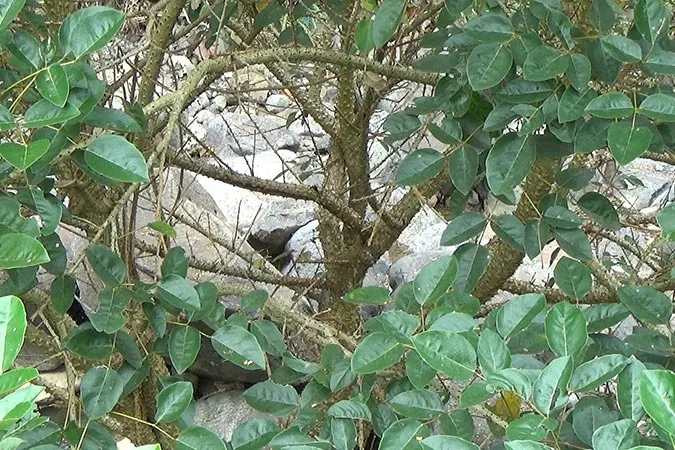Cangkring (Erythrina fusca) is a plant species in Fabaceae, a large tree with fallen leaves, 10-20 m high, cylindrical and woody, grayish in color, rough surface with sparse branches and equipped with black thorns.
E. fusca has an erect stem, sympodial branching and sharp spines. Compound leaves with three strands, ovate with blunt tip and base, flat edge, 20-30 cm long, 4-10 cm wide and 10-15 cm stalk. The veins in the middle with several pinnate veins, glossy green upper surface and pale green lower surface.
Compound flowers, light orange, grow at the tip of the stem, cylindrical stalk and 2-3 cm long. The petals are tubular, have a slit tip and are pale green in color. Stamens 3 cm long, red in color, kidney-shaped anthers and yellow.
The pistil is cylindrical, 3 cm long, white, oval and yellow in color. The crown is butterfly shaped and red. Fruit pods and brown. Single root and brownish white.
Cangkring grows in forests, river banks, beaches, swamps and other places up to an elevation of 700 m. Spread from dry to humid tropics through dry subtropics to wet forested areas.
Every 100 grams of wet leaves contains 60 calories, 81.5 g water, 4.6 g protein, 0.8 g fat, 11.7 g total carbohydrates, 4.1 g fiber, 1.4 g ash, 57 mg calcium, 40 mg phosphorus, 1.8 mg Fe, 2300 mg equivalent to beta carotene, 0.24 mg thiamin, 0.17 mg riboflavin, 6.54 ng niacin and 78 mg ascorbic acid.
The leaves, bark and roots contain saponins and polyphenols, while the roots also contain flavonoids. The ethanol extract of the leaves and bark contains flavonoids, alkaloids and terpenoids.
The leaves are used to treat gabag, chicken pox, yaws, itching and to increase breastfeeding. The wood is kneaded to be drunk as a medicine to urinate blood or gonorrhea. The decoction of the roots or bark is used as a medicinal berry.
Kingdom: Plantae
Phylum: Tracheophyta
Subphylum: Angiospermae
Class: Magnoliopsida
Order: Fabales
Family: Fabaceae
Subfamily: Faboideae
Tribe: Phaseoleae
Genus: Erythrina
Species: Erythrina fusca
E. fusca has an erect stem, sympodial branching and sharp spines. Compound leaves with three strands, ovate with blunt tip and base, flat edge, 20-30 cm long, 4-10 cm wide and 10-15 cm stalk. The veins in the middle with several pinnate veins, glossy green upper surface and pale green lower surface.
Compound flowers, light orange, grow at the tip of the stem, cylindrical stalk and 2-3 cm long. The petals are tubular, have a slit tip and are pale green in color. Stamens 3 cm long, red in color, kidney-shaped anthers and yellow.
The pistil is cylindrical, 3 cm long, white, oval and yellow in color. The crown is butterfly shaped and red. Fruit pods and brown. Single root and brownish white.
Cangkring grows in forests, river banks, beaches, swamps and other places up to an elevation of 700 m. Spread from dry to humid tropics through dry subtropics to wet forested areas.
Every 100 grams of wet leaves contains 60 calories, 81.5 g water, 4.6 g protein, 0.8 g fat, 11.7 g total carbohydrates, 4.1 g fiber, 1.4 g ash, 57 mg calcium, 40 mg phosphorus, 1.8 mg Fe, 2300 mg equivalent to beta carotene, 0.24 mg thiamin, 0.17 mg riboflavin, 6.54 ng niacin and 78 mg ascorbic acid.
The leaves, bark and roots contain saponins and polyphenols, while the roots also contain flavonoids. The ethanol extract of the leaves and bark contains flavonoids, alkaloids and terpenoids.
The leaves are used to treat gabag, chicken pox, yaws, itching and to increase breastfeeding. The wood is kneaded to be drunk as a medicine to urinate blood or gonorrhea. The decoction of the roots or bark is used as a medicinal berry.
Kingdom: Plantae
Phylum: Tracheophyta
Subphylum: Angiospermae
Class: Magnoliopsida
Order: Fabales
Family: Fabaceae
Subfamily: Faboideae
Tribe: Phaseoleae
Genus: Erythrina
Species: Erythrina fusca
